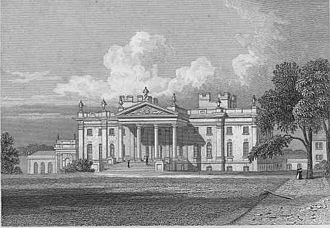Duncombe Park facts for kids
Quick facts for kids Duncombe Park |
|
|---|---|

Duncombe Park c. 1829
|
|
| General information | |
| Type | Stately home |
| Location | Helmsley, North Yorkshire |
| Country | England |
| Coordinates | 54°14′20″N 1°04′29″W / 54.23889°N 1.07472°W |
| Completed | 1713 |
| Owner | Feversham Estate |
| Grounds | 450 acres (182 ha) |
| Design and construction | |
| Architect |
|
|
Listed Building – Grade I
|
|
| Designated | 4 January 1955 |
| Reference no. | 1295358 |
| Designated | 10 May 1984 |
| Reference no. | 1001061 |
Duncombe Park is a grand country house located near Helmsley in North Yorkshire, England. It is the historic home of the Duncombe family. The estate covers about 300 acres of beautiful parkland. It sits high above the River Rye, within the North York Moors National Park.
The house was finished in 1713. It was designed for Thomas Duncombe by an architect named William Wakefield. Later, in 1843, Sir Charles Barry made some changes to the house.
In 1879, a big fire badly damaged the main part of the house. It stayed a ruin for many years. Then, in 1895, William Young rebuilt it. He followed the original design but updated the inside to fit modern needs. The house has two main floors, plus a basement and an attic.
While the house itself is not open to the public, you can visit the lovely 30-acre garden. The gardens are open from April until the end of August.
Contents
History of Duncombe Park
The story of Duncombe Park began in 1694. A very rich man named Charles Duncombe bought the huge Helmsley estate. It was about 40,000 acres! He sometimes stayed at Helmsley Castle.
When Charles Duncombe died in 1711, his sister Ursula inherited the estate. Her son, Thomas Brown, then took over. He changed his name to Thomas Duncombe. He was the one who ordered the building of the grand house we see today.
After Thomas Duncombe died in 1746, his son, Thomas Duncombe II, became the owner. He made the estate even bigger. He added the famous Rievaulx Terrace to the grounds. In 1774, Anne Duncombe, who was Thomas Duncombe's daughter, married Robert Shafto. He was the "Bonny Bobby Shaftoe" from the old folk song!
The Duncombe Family and Titles
Later, Thomas's son, Charles Slingsby Duncombe, owned the estate. In 1803, his eldest son, also named Charles, inherited it. This Charles was a Member of Parliament (MP) for several areas. He was also the High Sheriff of Yorkshire in 1790–91. He collected many valuable artworks for the house. In 1826, he was given the title of 1st Baron Feversham.
His son, William, became the next Baron. William was also an MP for Yorkshire. His son, William Ernest, was given an even higher title: the 1st Earl of Feversham.
Sadly, the second Earl was killed during the First World War. The title of Earl ended when the third Earl died in 1963. Since then, the senior members of the family have been known as Baron Feversham.
Duncombe Park in Recent Times
From 1914 to 1980, Duncombe Park was used as a girls' school. In 1972, the National Trust took over the Rievaulx Terrace and its temples.
Since 1985, the 6th Baron Feversham worked to restore the house. He wanted it to be a family home again. When he passed away in 2009, he left the house to his younger son, Jake Duncombe, instead of his eldest son. Duncombe Park is a Grade I listed building. This means it is a very important historic building.
The house stopped being open to the public in 2011.
Duncombe Park in Films
Duncombe Park has been used as a filming location for TV shows and movies.
- In 2012, it was used for the TV mini-series Parade's End. It played the role of a fictional house called Groby Hall. The show starred Benedict Cumberbatch and Rebecca Hall.
- In 2013, it appeared in the film The Thirteenth Tale. It was used as the mysterious Angelfield House.
Birds of Prey Centre
In March 2013, a special place opened in the grounds of Duncombe Park. It is called the National Centre for Birds of Prey. Here, you can see many different kinds of birds of prey.


